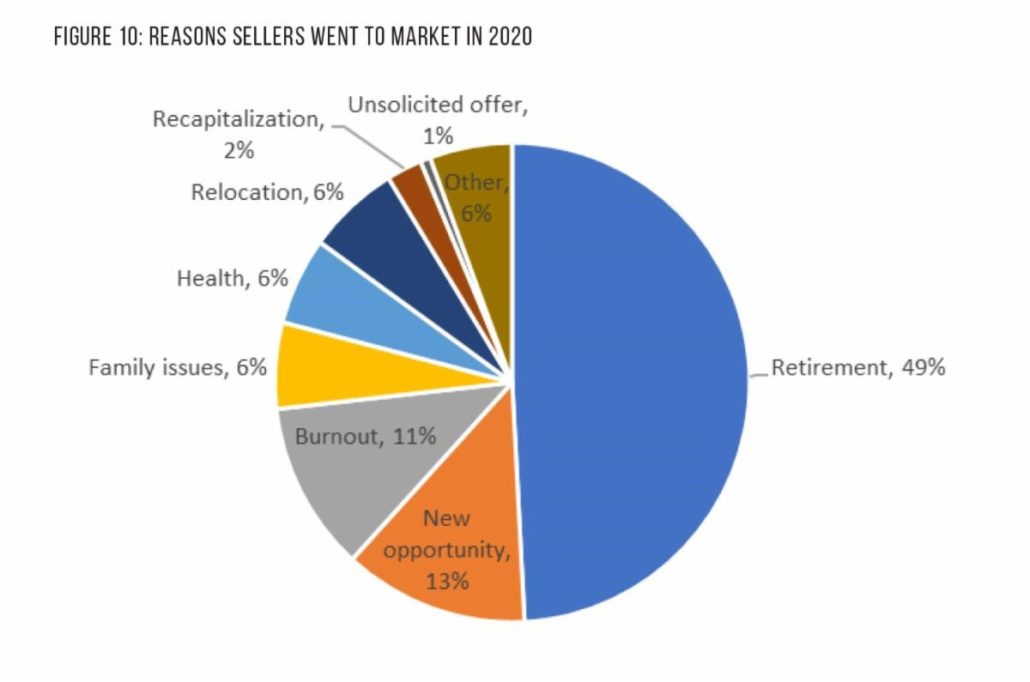 One of our former clients, Joe, reflecting on the sale of his company said, “only those of us that have toiled at it know what it really takes to succeed in this business.” How true. Until we risk our own capital and spend years building a team, perfecting products and processes and managing through multiple business cycles, we can’t fully appreciate what it takes to succeed in a given business. Similarly, its hard for business owners, who sell a business once or twice in their lives, to understand the value that a professional M&A advisor brings to the table.
One of our former clients, Joe, reflecting on the sale of his company said, “only those of us that have toiled at it know what it really takes to succeed in this business.” How true. Until we risk our own capital and spend years building a team, perfecting products and processes and managing through multiple business cycles, we can’t fully appreciate what it takes to succeed in a given business. Similarly, its hard for business owners, who sell a business once or twice in their lives, to understand the value that a professional M&A advisor brings to the table.
Fortunately, owners can take a lesson from private equity groups who always hire an M&A advisor or investment banker to sell a portfolio company, even when they know the likely buyers. Why? They know they do better financially when an independent M&A advisor runs the sale process. And keep in mind, these are sophisticated operators. Most are former investment bankers! They also recognize that their time is better spent on things like business performance and sourcing new investments. They also know that using an M&A advisor helps convince limited partners that they have obtained the best deal available in the market.
Why then are owners tempted to sell on their own?
I can save money.
Would you ever file your own taxes, draft your own living trust, manage your own 401(k) or sell your own house to save money? Why on earth then would you try to sell a company on your own? Aside from the probability of making costly mistakes, your time will be better spent optimizing business performance than moonlighting as an M&A expert. Buyers’ obsession with trailing-12-month (TTM) business performance is hard to overstate — so focus on it!
We don’t provide legal or tax advice, but attorney and CPA hours can easily double when you don’t have an M&A advisor leading the sale process. And the likelihood of closing a deal goes down, so you may spend more on professional fees and end up with no deal. Please understand that I have the utmost respect for M&A attorneys and CPA’s and their critical roles in the process, but those are the facts!
Most importantly, the impact that an M&A advisor has on price and terms usually covers their fee many times over.
I can negotiate a better deal.
Just because a buyer is willing to pay $40 million, doesn’t mean that they will offer $40 million. You usually only see their best offer if they think they are going to lose the deal to another bidder. It is that simple. Owners who represent themselves usually negotiate with one buyer, maybe two. We bring additional serious buyers to the table, which creates competition.
And signing a letter of intent (LOI) for $40 million doesn’t mean your deal will close at that price. M&A advisors spend a great deal of time and effort educating buyers prior to LOI negotiation to avoid re-trading during due diligence. They make sure that LOI terms are clear and detailed so that you know what you are getting. They clarify overly broad and ambiguous language that buyers will interpret in their favor. Skills like this only come with deal making experience.
More likely than not, you will leave money on the table if you go it alone. Recently we sold a company to a buyer who’s final bid was double their initial offer. Many times, we’ve increased purchase prices 20 to 50 percent through competitive bidding.
I will have more control.
When a buyer approaches you directly, they will have you sign their NDA, dictate discovery and meetings, and control the negotiation process (probably ask you to name a price). As their process unfolds, you will feel more out of control than you’ve ever felt in business, and you will be playing right into their hand.
If the time is right for you to sell, better to take a step back and get an M&A advisor on your team to evaluate your situation and run a professional sale process. Someone who will answer your questions, help you prepare, gain control of the process, and advocate for you throughout the process. Someone with years of experience, preferably in your industry, who has either been referred, done a good job for someone you know, or at least has good references.
With an M&A advisor on your team, not only will you get more in the end, but you are more likely to get a deal done, and get it done faster and more efficiently.
I will have a better relationship with the buyer.
The fact is, hiring an M&A advisor preserves your relationship with the ultimate buyer. We do the heavy negotiating, so you don’t have to, and we bring objectivity and expertise to your team.
You may be approached by representatives of a company with whom you have a relationship, and so far they’ve been very cordial. But don’t be fooled. Sure, they’re great people from a solid company, but there’s a reason they want to deal directly with you, not with an M&A advisor. They know they can buy at a lower price and on better terms.
Their strategy is to become your friend, keep competition out, keep you underrepresented, and control the process. Often, when going it alone, it is only after you have been worn down with discovery, due diligence and negotiations and are emotionally exhausted, that you see their final terms. It is also possible that by then TTM performance has declined because you and your team got distracted, and one or more key employees, vendors or customers has gotten wind of the potential sale, further eroding your negotiating position.
Of course, it is important to like and trust who you are selling to. An M&A advisor provides for that AND allows you to retain control, maintain confidentiality, see offers from other buyers, and secure the best deal for you, your partners and your family.
The truth is that, other than the fact that they will likely pay more, buyers like having a sell-side M&A advisor involved because it makes the rest of the process smoother. For example, the advisor will tee up a Confidential Information Memorandum (CIM) and data room that provides the information they need to confidently bid on the company. And rather than create financial models from scratch, they often just build on the models prepared by the advisor.
Do the right thing, get an M&A advisor.
To improve your financial outcome and have a more efficient transaction process, get an M&A advisor involved. The terms of your deal will soon be forgotten by the buyer. For them, time cures overpayment; but you don’t get a second chance to sell your business. You must get this right the first time!
A few years ago, a survey of lower middle market sellers found that the most valuable services provided by M&A advisors (investment bankers) were “managing the M&A process & strategy”, “structuring the transaction”, and “educating and coaching the owner”. Interestingly, the least valuable service was “identifying and finding the buyer”. Here’s a summary of that survey.
Another one our former seller clients, Brian, said something really insightful. He said, “Al, when I hired your firm, I had been CEO of our company for 20 years and was our best salesperson; but thankfully I recognized that selling our company was an entirely different thing.”
Al Statz is President and founder of Exit Strategies Group, a leading California-based M&A advisory firm with decades of experience selling manufacturing, distribution and service companies in the lower middle market. For further information, or to discuss a potential sale or acquisition, confidentially, contact Al Statz at 707-781-8580. This article was inspired by a post by Al’s friend and CIA colleague Mike Mensch an M&A advisor to insurance agencies across the U.S.











 One of our former clients, Joe, reflecting on the sale of his company said, “only those of us that have toiled at it know what it really takes to succeed in this business.” How true. Until we risk our own capital and spend years building a team, perfecting products and processes and managing through multiple business cycles, we can’t fully appreciate what it takes to succeed in a given business. Similarly, its hard for business owners, who sell a business once or twice in their lives, to understand the value that a professional M&A advisor brings to the table.
One of our former clients, Joe, reflecting on the sale of his company said, “only those of us that have toiled at it know what it really takes to succeed in this business.” How true. Until we risk our own capital and spend years building a team, perfecting products and processes and managing through multiple business cycles, we can’t fully appreciate what it takes to succeed in a given business. Similarly, its hard for business owners, who sell a business once or twice in their lives, to understand the value that a professional M&A advisor brings to the table.



